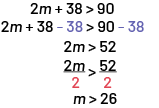C2.4 Solve inequalities that involve two operations and whole numbers up to 100 and verify and graph the solutions.
Activity 1: Solving a Non-Strict Inequality
Ask students to solve the inequality \( 5x + 50 \leq 100 \) and represent their solution using a number line.
Strategy
Represent this Inequality Using a Number Line
First I need to isolate the variable x.

Since the equation includes the equal sign, I can draw a closed dot on the number 10 with the line arrowed to the left to show the results "all numbers less than or equal to 10".

The possible values of x are the whole numbers less than or equal to 10, namely 10, 9, 8, 7, 6, 5, 4, 3, 2, 1 and 0.
Source: translated from En avant, les maths!, 6e année, CM, Algèbre, Résolution d'inégalités, p. 3.
Activity 2: Solving a Strict Inequality
Have students solve the inequality \(2m + 38 < 90\) and represent their solution with a number line.
Strategy
Represent Solutions Using a Number Line
To represent this inequality on a number line, I first need to isolate the variable m.


I draw a line and use the open dot, on the number 26, to indicate that the inequality relation is "greater than" 26. The possible values of m are the whole numbers greater than 26, namely 27, 28, 29, etc.
Source: translated from En avant, les maths!, 6e année, CM, Algèbre, Résolution d'inégalités, p. 4.
Activity 3: Working to Spoil Yourself!
Present students with the following problem:
Erykah found three pairs of running shoes that she likes, costing $50, $59 and $79 respectively. She has already saved $31. She works for a dog walking service that pays her $15 per hour. How many hours will she have to work to buy any of these pairs of shoes? Represent your solution on a number line.
Encourage students to work in teams to solve the problem.
Example
Represent the problem algebraically using an inequality:
Erykah earns $15 x h, where h is the number of hours worked.
The first pair of shoes costs $50, and Erykah has already saved $31. So, to buy these shoes, Erykah must have $50 - $31.
To find the number of hours Erykah will have to work to buy the first pair of shoes, the algebraic inequality is:
15 x h ≥ 50 - 31
15 x h ≥ 19
| h | 15 x h | ≥ 19 |
|---|---|---|
| 0 | 0 | no |
| 1 | 15 | no |
| 2 | 30 | yes |
| 3 | 45 | yes |
15 x h ≥ 19
15 x 2 ≥ 19
Erykah has to work 2 hours.
Ask a few teams to present their solution. Allow students to review their answer.
